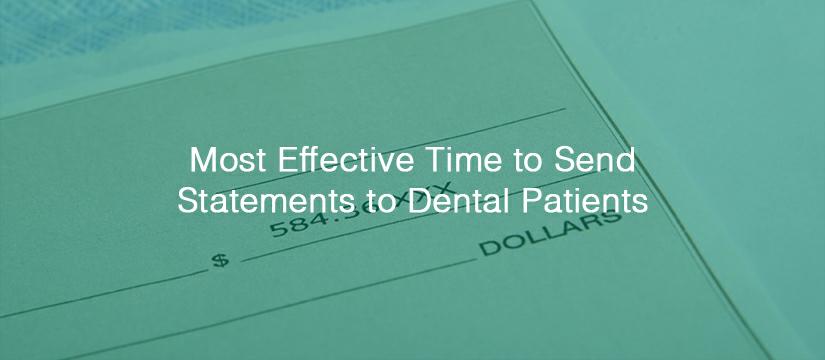The Most Effective Time to Send Statements to Dental Patients

A lot of dental practices today schedule the delivery of the billing statements, but this isn’t actually a recommended practice. In fact, having an outstanding account receivable isn’t very ideal in any business. Yes, this could help you get paid for the service or product at the moment it is sent, but insurance companies require the claims first before paying their portions of the treatment that was completed.
A good option is to make your patients pay 100% of their portion of the overall payment prior or on the day the service was done, then submit the claim to their insurance company. If this is done immediately, the office receives the remainder of the payment.
Unfortunately, one of the scenarios is impossible because things happen differently. First, the estimates are usually incorrect and insurances pay less. The remaining balance is then calculated for the patients to pay. The dental office then follows up with the patient to collect that remaining balance. In the current scenario, most dental offices send statements to patients with the amount paid by the insurance and remaining balance of the patient.
Sending balance due statements is necessary, therefore this can’t be avoided. With that being said, it’s important to consider the best time to send these statements. In some businesses, they have a scheduled day of each month to do it. This is actually good because it takes time to process statements. Having a set time is also good in a way because this ensures that the statements are sent out. Many dental offices have followed this philosophy and it works great. But one thing that is time-limited at the front desk of a dental office is “extra time”. So, it could be a good solution to send statements one day of the month.
BUT it is not recommended sending statements on a set day of each month. Here are three reasons why.
1. If patients send the bill sooner, it’s better.
After the procedure, the dental office normally submits its claim to the insurance company immediately. Once the insurance company is done with the processing of the claim, the EOB (Explanation of Benefits) is sent to the dental office and the patient receives a copy. What happens is that the patient looks at the EOB briefly, and doesn’t think about it again.
This is a problem because patients don’t remember the content of EOB, which states that the insurance company paid less the original estimate. Because patients are no longer associated with your bill statement pertaining to their procedure, they will be less concerned about paying something that is already a distant memory. To avoid this, you need to send the request for payment as soon as possible. Right after the procedure would be best.
2. Patients have short memory and you don’t have to play the bad guy role.
The important thing in EOB is that the recipients fully remember its content. Patients need to pay their balance not because dental offices declare so, but simply because the insurance company did not pay what was expected. Patients have to see how their insurances changed their dental coverage. This is to clear out that dental offices are not the bad guys.
3. Distribute payments and phone calls over the course of the month
It’s not right to send all statements in just one day in a month where patients receive their payments at the same time. The best option is to have a steady flow of payments throughout the month. Other than that, you will have questions and objections coming from patients who have remaining balances.
